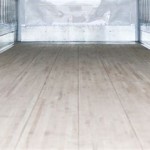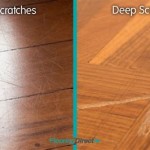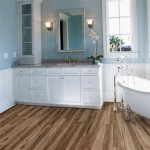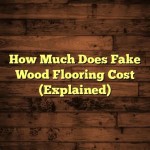Loft Flooring Ideas: Transforming Vertical Space with Style and Functionality
Loft spaces, characterized by their open floor plans, high ceilings, and often industrial aesthetic, present unique opportunities and considerations when selecting flooring. The choice of flooring material significantly impacts the loft's overall appearance, acoustics, comfort, and functionality. Navigating the array of options requires careful assessment of factors such as budget, lifestyle, existing structural elements, and desired design style. This article explores a variety of loft flooring ideas, delving into the characteristics, benefits, and potential drawbacks of each, providing a comprehensive guide for informed decision-making.
The open nature of loft spaces often necessitates a holistic approach to flooring selection. Flooring choices should complement the existing architectural features, such as exposed brick, ductwork, and large windows. Achieving visual harmony and creating distinct zones within the loft environment often requires careful consideration of color, texture, and patterns. Furthermore, the high ceilings inherent in loft spaces can amplify sound, making acoustic properties a crucial factor in flooring selection. Materials that absorb sound or can be combined with sound-dampening underlayments are often preferred. The following sections will delve into specific flooring options, each with its unique set of attributes.
Hardwood Flooring: Classic Elegance and Enduring Appeal
Hardwood flooring remains a popular choice for loft spaces due to its timeless elegance, durability, and ability to add warmth and character. The natural grain patterns and rich hues of hardwood contribute to a sophisticated and inviting atmosphere. Two primary types of hardwood flooring are commonly used: solid hardwood and engineered hardwood. Solid hardwood consists of planks made from a single piece of wood, while engineered hardwood features a veneer of hardwood bonded to multiple layers of plywood or fiberboard. Both offer distinct advantages and disadvantages.
Solid hardwood flooring offers exceptional longevity and can be refinished multiple times, extending its lifespan considerably. Its solid construction provides a robust and stable surface. However, solid hardwood is susceptible to moisture damage and expansion/contraction with changes in humidity, making it less suitable for areas prone to dampness or extreme temperature fluctuations. Furthermore, its installation typically requires professional expertise and can be more costly than other flooring options. Consider the type of wood to use. For example, oak is a popular, durable choice while cherry is a softer, more delicate wood.
Engineered hardwood flooring offers greater stability and resistance to moisture compared to solid hardwood. Its layered construction minimizes the risk of warping or buckling, making it a suitable choice for loft spaces with varying humidity levels. Engineered hardwood can also be installed over concrete subfloors, offering versatility in loft layouts. While it cannot be refinished as many times as solid hardwood, it provides a cost-effective alternative with a similar aesthetic appeal. The thickness of the hardwood veneer is a key factor in determining its refinishing potential and overall durability.
When selecting hardwood flooring for a loft, consider the color, grain pattern, and finish. Lighter-toned hardwoods can brighten up a space and create a more open feel, while darker tones evoke a sense of warmth and sophistication. Wider planks can visually expand a room, while narrower planks offer a more traditional look. A matte finish is ideal for hiding scratches and wear, while a glossy finish provides a more polished appearance. Ultimately, the choice of hardwood flooring should complement the overall design aesthetic and address the specific needs of the loft environment.
Concrete Flooring: Industrial Chic and Modern Versatility
Concrete flooring has emerged as a popular option for loft spaces, particularly those embracing an industrial or minimalist aesthetic. Its raw, unadorned appearance offers a contemporary edge, while its durability and versatility make it a practical choice. Concrete flooring can be polished, stained, sealed, and even textured to achieve a variety of looks, allowing for customization to suit individual preferences. The inherent thermal mass of concrete can also contribute to energy efficiency by retaining heat during colder months and providing a cooling effect during warmer periods.
Polished concrete offers a sleek and sophisticated look, revealing the aggregate and variations within the concrete slab. The polishing process creates a smooth, reflective surface that is easy to maintain and resistant to staining. Staining concrete allows for the introduction of color and depth, creating a unique and personalized look. A variety of stains are available, ranging from subtle earth tones to vibrant hues. Sealing concrete is essential to protect it from moisture penetration and staining. Sealers create a protective barrier that prevents liquids from seeping into the porous concrete surface. Consider using epoxy sealers to protect against moisture and chemical damage.
Textured concrete can be achieved through various techniques, such as stamping, scoring, or etching. Stamping creates patterns and designs on the concrete surface, mimicking the look of brick, stone, or tile. Scoring involves cutting shallow grooves into the concrete to create geometric patterns or borders. Etching uses acid to create a textured surface, adding depth and visual interest. The thickness of the concrete slab is a critical factor in its structural integrity and ability to withstand heavy loads. A properly reinforced concrete slab is essential to prevent cracking and settling.
While concrete flooring offers numerous advantages, it also has some potential drawbacks. Concrete can be a cold and hard surface underfoot, which may necessitate the use of rugs or area carpets for added comfort. Concrete is also inherently porous and susceptible to staining if not properly sealed. Furthermore, concrete can be prone to cracking, particularly in areas with significant temperature fluctuations or ground movement. Careful preparation of the subfloor and proper installation techniques are essential to minimize the risk of cracking. Consider the overall cost of concrete flooring, including the cost of polishing, staining, sealing, and any necessary repairs.
Laminate Flooring: Affordable Durability and Realistic Aesthetics
Laminate flooring provides a cost-effective alternative to hardwood and other natural flooring materials. It consists of a multi-layered synthetic material, typically featuring a high-density fiberboard (HDF) core topped with a decorative layer that mimics the appearance of wood, stone, or tile. Laminate flooring is known for its durability, scratch resistance, and ease of installation, making it a popular choice for budget-conscious homeowners. Modern laminate flooring technology has advanced significantly, producing realistic textures and patterns that closely resemble natural materials.
The primary advantages of laminate flooring include its affordability, durability, and ease of installation. Laminate is typically less expensive than hardwood, tile, or stone, making it an attractive option for large loft spaces. Its durable wear layer protects against scratches, dents, and fading, making it suitable for high-traffic areas. Laminate flooring features a click-lock system that allows for easy installation without the need for glue or nails, making it a DIY-friendly option. Consider the thickness of the laminate flooring, as thicker planks generally offer greater durability and stability.
While laminate flooring offers numerous benefits, it also has some limitations. Laminate flooring is not as moisture-resistant as some other flooring options, and it is not recommended for areas prone to dampness or spills. While laminate flooring can mimic the appearance of natural materials, it lacks the inherent warmth and texture of real wood or stone. Laminate flooring cannot be refinished, unlike hardwood, and must be replaced if damaged. The quality of the laminate flooring is a crucial factor in its appearance and durability. Higher-quality laminate flooring features more realistic textures and patterns and is more resistant to wear and tear.
When selecting laminate flooring for a loft, consider the color, texture, and pattern. Lighter-toned laminates can brighten up a space and create a more open feel, while darker tones evoke a sense of warmth and sophistication. Embossed laminates feature a textured surface that mimics the grain of wood or the texture of stone, adding visual interest. Waterproof laminate flooring is available, offering enhanced protection against moisture damage. Consider using underlayment beneath the laminate flooring to provide cushioning, sound absorption, and moisture protection. Finally, consider the cost of laminate flooring installation, including the cost of underlayment and any necessary tools or supplies.
Other Flooring Options: Exploring Alternative Materials for Unique Loft Spaces
Beyond hardwood, concrete, and laminate, a variety of other flooring options can be considered for loft spaces, each offering unique aesthetics and functional benefits. These include tile, vinyl, and cork flooring, among others. The suitability of each option depends on the specific needs and design preferences of the loft owner.
Tile flooring, available in ceramic, porcelain, and stone varieties, is known for its durability, water resistance, and versatility. Tile is an excellent choice for bathrooms, kitchens, and other areas prone to moisture. Porcelain tile is particularly durable and resistant to staining, making it a popular choice for high-traffic areas. Stone tile, such as granite or marble, offers a luxurious and elegant look. Consider the size and shape of the tile, as larger tiles can create a more seamless look, while smaller tiles can add texture and visual interest. Grout color is an important consideration, as it can significantly impact the overall appearance of the tile flooring. Finally, consider the cost of tile installation, which can be more expensive than other flooring options due to the need for specialized tools and expertise.
Vinyl flooring offers a cost-effective and durable alternative to tile and other hard flooring materials. Vinyl flooring is available in sheet, tile, and plank formats, offering a variety of design options. Vinyl flooring is water resistant, stain resistant, and easy to clean, making it a practical choice for kitchens and bathrooms. Luxury vinyl plank (LVP) flooring offers a realistic wood look and is more durable than traditional vinyl flooring. Consider the thickness of the vinyl flooring, as thicker planks or tiles generally offer greater durability and stability. Waterproof vinyl flooring is available, offering enhanced protection against moisture damage. Finally, consider the cost of vinyl flooring installation, which is typically less expensive than tile or hardwood installation.
Cork flooring is a sustainable and eco-friendly option that offers unique benefits. Cork is a natural, renewable resource that is harvested from the bark of cork oak trees. Cork flooring is naturally resilient, providing cushioning and sound absorption. Cork is also hypoallergenic and resistant to mold and mildew, making it a healthy choice for allergy sufferers. Cork flooring is available in tiles and planks, offering a variety of design options. Consider the thickness of the cork flooring, as thicker planks or tiles generally offer greater durability and insulation. Sealing cork flooring is essential to protect it from staining and moisture damage. Finally, consider the cost of cork flooring installation, which can be more expensive than laminate or vinyl installation.

Flooring Ideas And Considerations For Your Loft Conversion Love Chic Living

How To Install A Floor In Your Loft Or Attic Esb Flooring

Maximise Your Home Transform Lofts With Smart Solutions

The Best Flooring Options For A Converted Loft Space Rachel Bustin

Loft Boarding And Flooring Guide Attic Board Benefits For 2024

15 Innovative Loft Ideas Angi

Loft Boarding And Flooring Guide Attic Board Benefits For 2024

19 Painted Concrete Patio Designs To Inspire Your Next Budget Friendly Update

Our Top 6 Loft Room Ideas

A Guide To Choosing The Perfect Loft Flooring Simply
Related Posts








